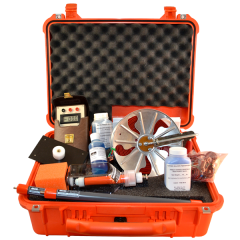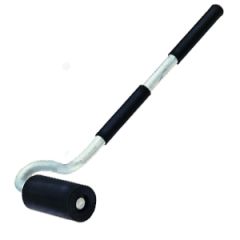Model UT Under Tank Reference Electrode by EDI
Description
Model UT reference electrodes are designed for taking potential profiles through perforated or slotted pipes beneath aboveground storage tanks. Contact to the electrolyte is through an all wood membrane which is more resistant to breakage and will not clog with salts or dry out as rapidly as a ceramic membrane.
Electrodes outfitted with two non-metallic ring bolts can be pulled through from either end of the pipe. When access is only available at one end of the pipe, use the S version which has a threaded socket at one end. This can be pushed or pulled from the open end.

Applications
Measuring potential profiles in perforated or slotted pipes beneath aboveground storage tanks
Features
- All wood membrane for contact to the electrolyte
- #14 RHW/USE lead wire is standard
Model UT1
Model UT1 was designed for use on tanks where the undertank piping terminates in a short radius ell. A user-attached sponge can be fitted to reduce contact resistance.
Weight - approx. 1 lbs (1/2 kg) plus wire #14 RHW wire: 1.5 lbs (0.7 kg) /100 ft (30 M)
Design life – 5 years (intermittent use).
Model UT2 and UT3
Models UT2 (for 2 in. dia. pipe) and UT3 (for 3 in. dia. pipe) can be left permanently in place in the slotted pipe and pulled through whenever potential profiles are required.
Weight - approx. 2 lbs (1 kg) plus wire #14 RHW wire: 1.5 lbs (0.7 kg) /100 ft (30 M)
Design life – 10 years (intermittent use).
Installation Instructions
These instructions apply to EDI Model UT undertank reference electrodes with gelled copper/copper sulfate (Cu/CuSO4, model code CUG) or gelled silver/silver chloride Ag/AgCl, model code AGG) elements. After removing electrode from carton, record the serial number and QC test potential; these are located on the yellow tag attached to the lead wire. Be sure to follow the correct procedures. Failure to follow these procedures will significantly shorten the life of the product.
Storage
Models UT2 and UT3: When the electrode will not be used for more than a week, the vinyl cap should be placed so that it covers the wood membrane. If the vinyl cap is lost or damaged, an alternative storage procedure is to wrap the wood membrane with a damp (potable water) paper towel and then overwrap it with either a clingy plastic wrap or aluminum foil to retard evaporation. Model UT1: Use the overwrapping procedure described above.
The electrode should be stored indoors at room temperature and out of the sun. Before reusing the electrode, remove cap or overwrap and soak it for a couple of hours in potable water. Model UT2 and UT3 electrodes may be left in the perforated pipe beneath the tank provided it is in a location where the temperature will not exceed 110ºF (45ºC).
Usage
Before pulling the reference electrode through a perforated pipe for the first time, the pipe must be flushed and cleared by dragging a dolly of equal or greater diameter through it in order to clear any obstructions. This pipe should be covered when not in use. Tow lines are to be attached to both eyebolts for pulling the reference electrode. Never pull the reference electrode by pulling on the lead wire. There must be a moisture film on the bottom of the perforated pipe in order to make valid potential measurements; it may be necessary to flush the pipe to create this film. Since the measurement path usually has high resistance, it will be necessary to use a high input impedance (>100 Meg) meter to obtain a valid reading.

Model UT1 undertank reference electrode is designed to fit through short radius 2 inch pipe ells. This allows the development of under-tank potential profiles using existing piping installed for monitoring purposes. For tanks with long radius pipe ells, model UT2 or UT3 is preferred.
Note: This product is intended for short term use when developing potential profiles beneath an AST. It will not provide long term performance in continuous use.
Model UT3 is designed for use in slotted pipes 3 inch diameter or larger with long radius ells. Use model UT1 in pipes with short radius ells.
Model UT2 is designed for use in slotted pipes 2 inch diameter or larger with long radius ells. Use model UT1 in pipes with short radius ells.
|
Specify as EDI Model UTz-xxx-LWnnn where |
Element Types AGG = saturated gelled Ag/AgCl |

Model UT3S is designed for use in slotted pipes 3 inch diameter or larger.
Socket-end UT2 and UT3 reference electrodes have a 1 inch NPT female pipe thread on the wire end and a solid end cap on the other end. All other dimensions and features are similar to the eye-bolt ended electrodes.

Model UT2S is designed for use in slotted pipes 2 inch diameter or larger.
|
Specify as EDI Model UTz-xxx-LWnnn where |
Element Types AGG = saturated gelled Ag/AgCl |

Model UT1S is designed for use in slotted pipes smaller than 2 inches. It has a 3/4 NPT-F thread on the wire end and a nylon bolt securing the sponge on the other end. All other dimensions and features are similar to the eye-bolt ended electrodes.
Socket end undertank reference electrodes are designed for use in slotted pipes where only one end is accessable. A threaded PVC pipe is attached to the wire end and the electrode pushed through the pipe.









